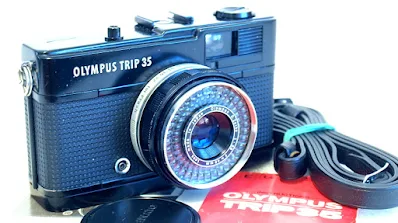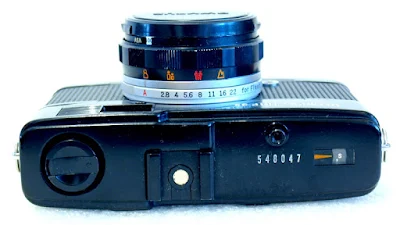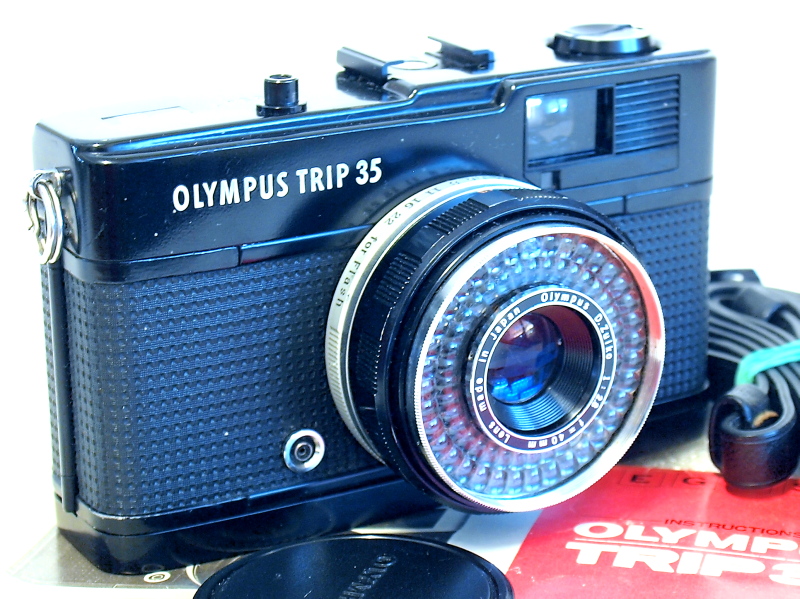Talk about the essence of 'iconic' 35mm compact cameras of yesteryears, cameras that help bring photography to the masses, cameras that are as equally functional as it is easy to use, cameras that are automatic but do not require a battery to operate, cameras with super sharp f/2.8 lenses, and the Olympus Trip 35 is always the one camera that will come to mind.
The Olympus Trip 35, a fully automatic viewfinder camera, is a point-and-shoot 35mm compact model manufactured by Olympus. It was introduced to the market in 1967 as a compact, functional camera for holidays, went on to become very popular among the masses, and sales ended in 1984 after a prolonged production run, with over ten million units sold.
The camera is fitted with a coated non-interchangeable 40mm f/2.8 D. Zuiko lens, acknowledged as being very sharp and capable of capturing high-quality images, and operates as a programmed automatic with only two shutter speeds, at 1/40th sec or 1/200th sec. At apertures of between f/2.8 to f/22.
SCL Photography Guide: The Olympus Trip 35 Film Camera
A fresh look at an old classic, to get you shooting your old Trip 35 or perhaps to interest you in investing in this great little film camera. Includes guide to buying, checking, loading and shooting with the camera. Bonus flash guide at the end. Thanks, Rob.
A low-light lock, with a red flag indicator, prevents you from taking under-exposed shots or trying it with the lens cap on.
Production Models
The design of the camera is simplicity itself. Early production units of the Trip 35 are manufactured with a silver shutter release button, with a film ISO speed rating from 25 to 200. Later production units, manufactured after 1978, come with a black plastic shutter release and a higher film ISO speed rating of 25 to 400. The Trip 35 is also available in black, which is much sought after by collectors.
The lens and lens mount are located centrally on the front of the camera, with a viewfinder window on the right front of the top plate, and a flash sync socket on the lower left of the lens mount.
On the top plate are the rewind crank, housed in a nice recessed area on the left of the top plate, the accessory shoe (located slightly off-center), the shutter release button, and on the right, the frame counter.
The Trip 35 comes with a plain film back, with only the viewfinder eyepiece and film forward wind at the back of the top plate. The hinge-type film back is opened by pulling down on a latch lever lock located on the film chamber side of the film box.
The bottom plate carries the tripod socket and the rewind release button.
The film box is Olympus easy-load type, with the film chamber, shutter frame window, film guide sprocket, and a multi-slot takeup spool laid sequentially from left to right. Film loading is the normal 2-blank shot to forward the film to frame 1.
Year of Production
If you are interested in knowing when your camera was produced, you need to open the film compartment, remove the pressure plate on the back of the door by sliding it free from its locating pins, and look for the 3-character manufacturer's code on the back of the pressure plate.
- The 1st character or letter (in later models) signifies the assembly plant.
- The 2nd number represents the last digit of the year of assembly, e.g., 6 = 1976, 0 = 1980
- The 3rd number or letter represents the month of assembly, 1-9 for Jan-Sep, X, Y, and Z for Oct-Dec.
For example, if the code reads N2Y, then the production was in November 1972
Viewfinder Readout
The viewfinder is an albada-type bright frame, with frame lines and parallax markings for closer focusing.
There is a second, very small window under this, nicknamed the "Judas window", which shows the current aperture setting and distance symbol that are on the lens barrel.
A small red flag will appear in the viewfinder if the auto-exposure mechanism decides there is not enough light and refuses to fire.
Film ISO Speed
The camera will accept films with an ISO speed, for later models, of 25–400. Earlier models, from the first few years of production, had a maximum ISO speed of 200. A hot shoe and a Prontor-Compur sync connector provide for flash photography.
Zone Focusing
The Olympus Trip 35 focuses manually with a simple four-position zone-focus system, with distance settings displayed on the top scale in graphic form, and a bottom scale calibrated in both meters and feet. Focusing distances are 1 meter, 1.5 meters, 3 meters, and infinity.
Shutter Speeds
In Auto Mode, the shutter speed is set to 1/200th sec, and exposure is automatically controlled by aperture opening, whilst in manual or flash sync mode, the shutter is set to 1/40th sec, and a range of aperture openings from f2.8 to f22 can be selected for the shot.
Battery Not Included
The Olympus Trip 35 is built with a solar-powered selenium light meter, and it does not need any batteries to run and operate. It is ideal for both the new user just getting into photography and the seasoned operator who wants slightly better control over the aperture setting and zone focusing mode. An accessory shoe and flash sync connector provide for flash photography.
Using The Camera
As with a fully automatic point-and-shoot camera, be it a film or digital, the Olympus Trip 35 is easy and fun to use.
Aside from the need for a roll of film to be loaded into the camera, be sure to set the correct film speed (ASA) setting by turning the ASA ring in front of the lens barrel so that the ASA speed is displayed in the small opening.
Set the aperture or F-stop ring to 'A' for Auto, and off you go.
For the zone-focusing part of the equation, give it a go at estimating the distance of your subject, or turn the focal ring graphic icons to match the subject of your composition, be a portrait or head-shoulder shot, a three-quarter height shot, a group shop or just a view of the land, sea or urbanscape.
Early Images
A friendly shop assistant showed off his antics.
Do remember to check the zone focus setting as you go on with your shooting assignment. On bright and clear days, the 40mm f/2.8 lens can be very forgiving and will stay sharp most of the time, but when things get a little dark and the automatic aperture falls to below f/5.6, you will tend to get blurred images if the zone focusing distance is not just right.
Olympus Trip 35 Instructions: Click here to download from www.buktus.org


























She is nice in black, too, but I like the silver/black better ;-)
ReplyDeleteOthers may not agree with you, but I do believe that the current film camera enthusiasts are more inclined toward the silver/blacks... thanks
DeleteHey thanks for the article. You state that in Auto mode the shutter speed is set at 1/200 and with flash it's 1/40. In fact both shutter speeds are available in auto and it switches at a point around EV 12.5 from f11 1/40 to f5.6 1/200, depending on the available light. It'll shoot down to EV 8.5: 1/40 2.8 and almost up to EV 17: 1/200 f22 in auto mode. The available combinations are 1/40 f2.8-f11 and 1/200 f5.6-f22 and it looks to actually select third-stops across this range, or thereabouts. This can be seen by the needle trap mechanism - there is an armature to determine the shutter speed by how far the armature raises when the shutter is depressed; this engages at one of two different cutout heights with the meter needle (along with a corresponding stepped scale for aperture), depending how far the needle is deflected by the coil/selenium cell circuit.
ReplyDeleteIt's an ingeniously simple mechanism - and worth noting that even in the daylight, on a dull overcast day, your shutter speeds can easily be low enough to blur if you don't make an effort to steady the camera.
Thanks for the followup, great!
Delete